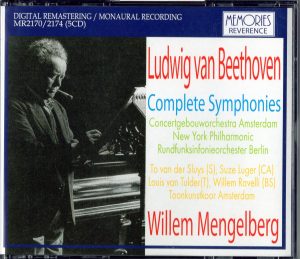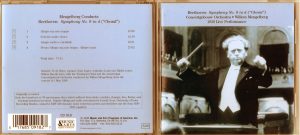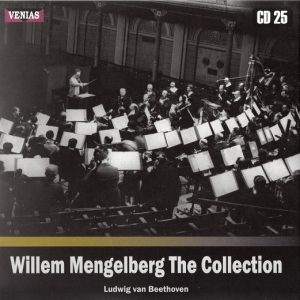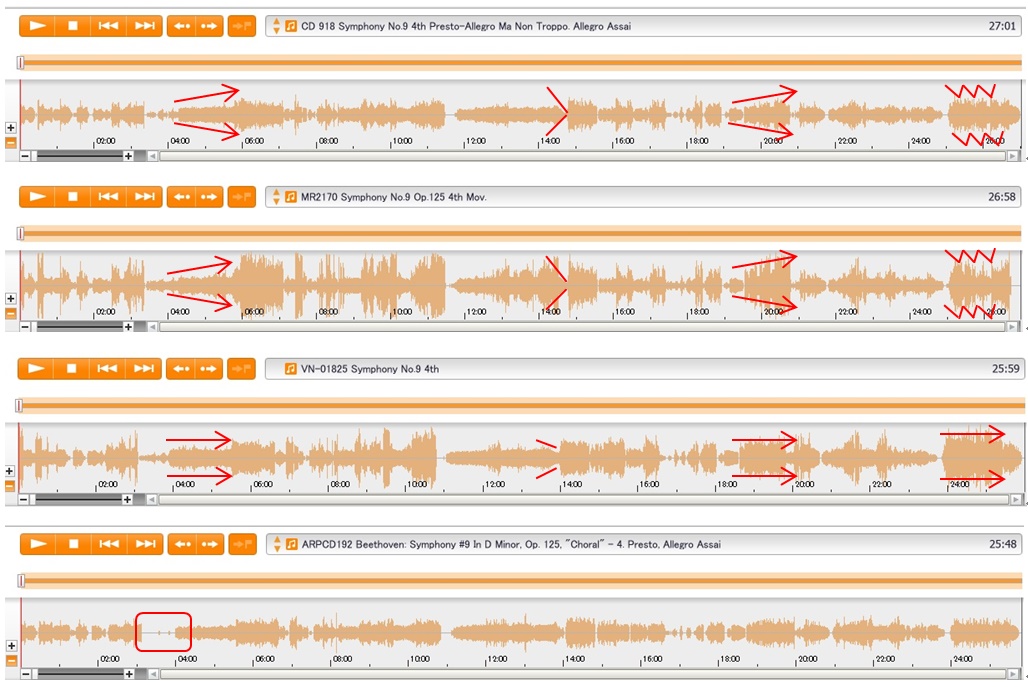
This page is about the performance of Beethoven’s Symphony No. 9 of Mengelberg, which is a record in 1938.
Below is the results of the analysis.
As a reference, I use the date of the Netherlands Willem Mengelberg Association.
May 31, 1938
June 1, 1938
Because of “Date uncertain”, this date has been left the possibility of another recording date.
I analyzed three CDs.
From conclusion, I believe that below,
Record of May 31, 1938: VN-01825
Record of June 1, 1938: CD 918, MR2170
So, I attach the data of the estimated basis below.
Details of CDs
CD title: Beethoven: Complete Symphonies
CD number: MR2170 (5th of 5CD sets of Symphonies)
Manufacturer: Memories
Recording of CD described date: May 31, 1938

Mengelberg Conducts Beethoven Symphony No.9 “Choral” 1938 Live Performance
CD number: CD 918
Manufacturer: Music & Arts
Recording of CD described date: May 1, 1938

CD title: Willem Mengelberg The Collection
CD number: VN-01825 (25th of CD BOX )
Manufacturer: VENIAS
Recording of CD described date: May 1, 1938

Time
MR2170
There is no description of the playing time on the CD.
These time of below are reading display play time of the CD player.
1st movement: 15:48
2nd movement: 12:29
3rd movement: 16:37
4th movement: 26: 58
CD 918
1st movement: 15:06
2nd movement: 12:10
3rd movement: 16:31
4th movement: 27: 02
VN-01825
1st movement: 15:14
2nd movement: 12:07
3rd movement: 16:17
4th movement: 25: 48
Data of May 31, 1938 according to the Willem Mengelberg Association
1st movement: 14:17
2nd movement: 11:34
3rd movement: 16:06
4th movement: 26:16
Data of June 1, 1938 according to the Willem Mengelberg Association
1st movement: 15:11
2nd movement: 12:18
3rd movement: 16:38
4th movement: 27: 00
Waveform of the CD playback sound
MR2170
1st movement

2nd movement

3rd movement

4th movement

CD 918
1st movement

2nd movement

3rd movement

4th movement

VN-01825
1st movement

2nd movement

3rd movement

4th movement

How to read the data
Playing time of the CD described (track playback time of the CD) is, in fact, is not accurate.
Whether they put a interval between the movement, or not,
Whether they count to the end of the sound from the first sound, or not,
The definition is iffy, moreover there might be a copy mistake, read mistake, write mistake(eg. typo).
For the waveform, you can not determine whether the same or different from the size of the amplitude of the waveform.
CD volume level at the time of recording for each has been different, because its own adjustment.
Based on the waveform, if you want to determine whether the performance is the same, one is but a certain volume, look at or to another waveform there is a climax.
Or to determine by the slope of the waveform of the places where with the intensity.
Even in another recording, something similar playing style, and has been with the same kind of intensity, the identification of the waveform is impossible.
This compares to focus on the 4th movement.
As a precaution, in addition to the 3 CDs kinds of 1938, recording of the May 2, 1940 (ARPCD192).
Recordings of the Beethoven’s Symphony No. 9 of Mengelberg are all in this combination so far.
It will be in the following order from top to bottom.
CD918 (1938)
MR2170 (1938)
VN-01825 (1938)
ARPCD192 (1940)

Fom the waveform of CD918 and MR2170, you could see almost the same trend.
The amplitude is seen a big difference, but this is mastering technician when turned into CD is a difference between whether or not to cut a certain frequency band, not a difference in the content.
In other words, when viewed from the waveform CD918 and MR2170 is, it seems to the same recording.
Compared to the 2 CDs (CD918 and MR2170) , VN-01825 is, there are a couple of places that show a clearly different trend.
First of all, the place where the first theme is played by the strings (Vlc. and Cb. next to Vla. and to Vl.),
In the 2 CDs (CD918 and MR2170) , the sound of the orchestra is gradually crescendo, but the VN-01825, has almost remained constant volume. This trend is the same, even the other two places in the figure.
Also, in the 2 CDs (CD918 and MR2170), extremely diminunendo after 14 minutes.
In score, just before entering the overall response of the third group in the ff from 543 measure through the interlude specific long development of the orchestra. The VN-01825 does not have a so extreme. Playing time also come before the 14 minutes.
From comparison of the waveform, but would become in such a description, but are actually listening, while the two(CD918 and MR2170) have been made intense expression with the amplitude, the VN-01825, proceed with great driving force, is the impression of it.
For reference, in the recording of the May 2, 1940, it is a great feature that the performance of the subject by the Vlc. and Cb. from 92 measure to 102 measure is played in a too very soft tone.Here are two types of recording of 1938, it is greatly different place.
By the way, in this ARPCD192 it has been noise removal, but in other CDs of 1940 have bubble wrap and noise entered in that part. Melody achieved by the Vlc. and Cb. hardly hear, only noise is the feeling that attaches to the ear.
Your ear is the most reliable
After all, it is recommended that you try to listen in your own ear of the actual sound.
For example, if you compare to listen to Reshitativo at the beginning of the fourth movement, I think the difference between the two types of performance is easy to understand.
And crucially, the recording of June 1, 1938, the fourth movement of 4 minutes ago (almost 3 minutes and 52 seconds), to around 100 bar and referred to in the score, a relatively large coughing noise it contains!
On the other hand, it does not exist in the recording of the May 31, 1938. (Of course it does not have at recording May 2, 1940)
Postscript
I’ll do the recorded waveform comparison of each CDs in 1940 in the near future, but looking at the waveform, there is something interesting is suggest the trend of re-mastering.
I think the MR2170 is the most abundant, including, and the impression that I heard was also similar.
Of course, is whether it is easy to listen to, will be another story.